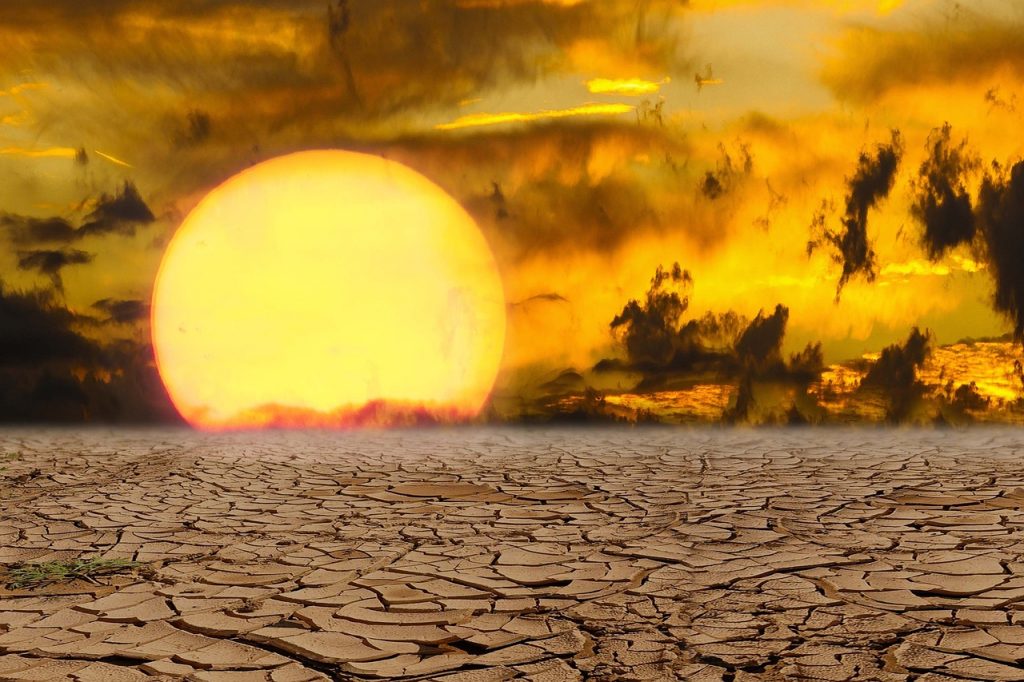Highlights
- Climate change is the biggest threat to agricultural production, caused by natural variability or human activity.
- It affects agricultural practices through variations in temperature, rainfall, extreme weather events, pests and diseases, atmospheric carbon dioxide, nutritional value of foods, growing seasons, and sea levels.
- Climate change leads to decreased crop yields, lower nutritional quality, changes in growing seasons, water availability and drought, extreme weather events, changes in pests and diseases, soil fertility changes, erosion, lengthened growing seasons, and increased carbon dioxide levels.
Food safety knowledge is for all!

Every consumer deserves to have high quality and safe food. …Read more!

The relationship between climate change and agriculture
Climate change is recorded globally as the biggest threat to agricultural production. It is defined as any change in climate over time, due to natural variability or as a result of human activity. The main course of climate change is mainly greenhouse gases (GHGs) accumulation in the atmosphere, hence an increased greenhouse effect. It has a wide range of impacts on agricultural practices, including variations in average temperatures, rainfall, and climate extremes, such as floods and droughts; variations in pests and diseases; variations in atmospheric carbon dioxide; variations in the nutritional value of some foods; variations in the growing season; and variations in sea level. Crop yields vary depending on plant development stages during extreme weather events and show a substantial association with temperature change and the length of heat or cold waves. In order to produce the food and fiber required to sustain human life, agriculture is highly reliant on weather and environment.
Impacts of climate change on crop production
Climate change has the potential to significantly impact crop production worldwide. Changes in temperature, precipitation patterns, extreme weather events, and rising levels of carbon dioxide (CO2) can affect various aspects of agricultural systems, leading to both direct and indirect consequences for crop yields and food security. Here are some key impacts of climate change on crop production:
- Decreased crop yields and lower nutritional quality – The effects of climate change are making it more difficult for agriculture to supply human needs. Additionally, due to variations in temperature, precipitation, and atmospheric carbon dioxide levels brought on by global climate change, the effects are unevenly spread around the planet. Rising temperatures, heat waves, and variations in precipitation (including droughts and floods) are all direct effects of shifting weather patterns.
- Changing Growing Seasons – Shifts in temperature and precipitation patterns can alter growing seasons, affecting the timing of planting, flowering, and harvesting. This can disrupt the synchronization between crops and pollinators, reduce yields, and potentially affect crop quality.
- Water Availability and Drought – Changes in rainfall patterns can result in more frequent or prolonged droughts, leading to water scarcity for crops. Drought stress can reduce crop productivity, impair nutrient uptake, and increase susceptibility to pests and diseases.
- Extreme Weather Events – Climate change is associated with more frequent and intense extreme weather events, including storms, floods, and heatwaves. These events can damage crops, destroy infrastructure, and result in soil erosion, leading to reduced yields and increased economic losses for farmers.

- Changes in pests, plant diseases, and weeds – Lower agricultural yields and nutritional value may also be a consequence of changes in pests, plant diseases, and weeds brought on by the climate. A side effect of climate change is the loss of agricultural land owing to sea level rise.
- Soil fertility changes, erosion, and lengthened growing seasons – As the temperature rises, fungi that produce mycotoxins and bacteria like Salmonella cause more harm to food safety and losses, adding to the associated cost pressures.
- Changes in Pest and Disease Dynamics – More harmful locust swarms may occur when hotter and rainier weather patterns are brought on by climate change. For instance, large locust swarms that were seen in the east African region in 2020. These insects may harm crops, reducing yields and endangering food security. Once more, climate change may have an impact on the fall army worm invasion of crops.
- Carbon Dioxide (CO2) Levels – Elevated atmospheric CO2 levels, associated with climate change, can affect crop physiology and productivity. While higher CO2 concentrations can stimulate photosynthesis and increase crop growth rates, the benefits may vary among crops and depend on other factors such as nutrient availability and water availability.
Read more about Sustainable Agriculture and Food Production: The Role of Food Science
Effects of climate change on livestock farming
Changes in climate result in raised temperatures which causes heat stress impacts an animal’s ability to grow, reproduce, and consume food. This in turn has an impact on meat and dairy product output. Heat stress causes a reduction in food intake, a slowdown in activity level, and a loss of weight.
Animals must have easy access to water and their feeding schedules must be changed to cooler hours of the day in order to reverse the reduction in livestock productivity. Additionally, a well-ventilated shelter can assist prevent heat exhaustion. The capacity of livestock of diverse species to withstand heat stress varies.
Climate change and fisheries
Climate change poses significant threats to fisheries on top of many other concurrent pressures such as overfishing, habitat degradation, pollution, introduction of new species and so on. Here are some key ways in which climate change affects fisheries:
- Ocean Warming: Rising global temperatures result in ocean warming. This can lead to changes in the distribution and abundance of fish species. Some species may move to cooler waters, affecting the composition of fish populations in different regions. This movement can also impact the livelihoods of fishing communities that depend on specific fish stocks.
- Altered Ocean Currents and Upwelling: Changes in ocean currents can affect nutrient availability and the process of upwelling, which brings nutrient-rich waters to the surface. Upwelling supports the growth of phytoplankton, a crucial food source for many fish species. Disruptions in upwelling patterns can impact the entire food web and result in changes in fish abundance and distribution.
- Coral Reef Degradation: Climate change contributes to the bleaching and degradation of coral reefs due to increased ocean temperatures and ocean acidification. Coral reefs serve as important habitats for numerous fish species, and their decline can disrupt fish populations and reduce fishery productivity.
- Ocean Acidification: Increased carbon dioxide emissions lead to ocean acidification, causing the pH of seawater to decrease. Acidic waters can adversely affect the development and survival of many marine organisms, including shellfish and coral reefs. These changes can disrupt the structure and function of marine ecosystems, impacting the availability of food and habitat for fish.
- Changing Productivity and Trophic Interactions: Climate change can alter primary productivity in the oceans, affecting the availability of food resources for fish. Changes in the timing and magnitude of plankton blooms can impact the growth and survival of larval fish, which rely on specific prey during critical life stages. Disruptions in trophic interactions can have cascading effects on fish populations and the overall productivity of fisheries.
- Increased Extreme Weather Events: Climate change is associated with more frequent and intense extreme weather events, such as hurricanes and storms. These events can damage fishing infrastructure, disrupt fishing operations, and impact the safety of fishermen. They can also lead to changes in the distribution and abundance of fish stocks as habitats and ecosystems are altered by extreme weather events.

Food waste and its contribution to climate change
The climate change dilemma is made worse by food loss and waste because of the large greenhouse gas (GHG) emissions it produces. Food-related activities including production, handling, and transportation emit a lot of carbon dioxide (CO2), and when it ends up in landfills, it releases methane, an even more potent greenhouse gas.
According to the EPA, the yearly carbon dioxide emissions from 42 coal-fired power plants are equal to 170 million metric tons of carbon dioxide equivalent GHG emissions from food loss and waste in the United States (Research | US EPA). The considerable methane emissions from food waste that is decomposing in landfills are not taken into account in this estimation.
Reducing and eliminating food waste can improve economic efficiency, productivity, and climate change mitigation. It can also address resource and energy conservation and reduce climate change-related shocks to the supply chain.
Sustainable farming practices to mitigate the impact of climate change
- Use of efficient irrigation schemes – Any farm must minimize its usage of water, especially during droughts. However, since groundwater pumping consumes the majority of the energy used on farms, irrigation efficiency is also essential for cutting back on fossil fuel use and greenhouse gas (GHG) emissions. Use of energy and water-saving techniques, including drip irrigation, cover crop planting, and dry farming, among others.
- Reduced use of fossil fuels in farming practices can significantly reduce the general effect on the climate. Alternatively, one may use solar energy, wind turbine as sources of energy. By transitioning to cleaner energy alternatives, such as solar energy and wind turbines, farmers can contribute to reducing greenhouse gas emissions and promoting a more sustainable agricultural sector. Embracing solar energy systems can harness the power of the sun to generate electricity for various farm operations, including irrigation, lighting, and machinery, while wind turbines can efficiently convert wind energy into usable power. These eco-friendly energy solutions not only reduce the carbon footprint associated with farming but also provide long-term benefits by minimizing reliance on fossil fuels, increasing energy independence, and potentially lowering operational costs for farmers.
- Embracing organic farming practices to significantly reduce greenhouse gas emission – Embracing organic farming practices can significantly reduce greenhouse gas emissions. Organic farming improves soil health, increasing carbon sequestration and mitigating emissions. By avoiding synthetic fertilizers and chemical pesticides, organic farming reduces emissions associated with their production and use. Water conservation techniques in organic farming reduce energy consumption and emissions from irrigation. Promoting biodiversity and adopting sustainable livestock management practices further contribute to emissions reduction. While organic farming alone cannot solve climate change, it is an important component of a comprehensive strategy that includes other sustainable practices to achieve significant emissions reductions.
- Championing for reforestation in lands hence keeping agriculture green – Reforestation in agricultural lands plays a vital role in keeping agriculture green and sustainable. By planting trees and restoring forested areas, reforestation helps mitigate greenhouse gas emissions through carbon sequestration. It also prevents soil erosion, supports biodiversity, regulates water resources, and creates microclimates beneficial for crop growth. Reforestation efforts promote environmental resilience, protect soil health, and contribute to climate change mitigation in agricultural landscapes. Collaboration among farmers, governments, and environmental organizations is essential to champion reforestation and ensure a greener future for agriculture.
- Proper farm plans that include decomposition of animal waste could help reduce the percentage of methane emissions to the atmosphere. One way of achieving this is by installation of biogas plants to produce cooking gas.
- Reducing the pressure of developmental projects on farm lands. The vast growth in urbanization greatly contributes to reduced arable land for food production and increases human activity which in turn increases emission of the greenhouse gases.
- Formulation of environmental protection policies. The formulation of environmental protection policies is essential for addressing environmental challenges. These policies should take a comprehensive approach, grounded in scientific research, and involve diverse stakeholders. Clear goals, regulations, and enforcement mechanisms are necessary, along with incentives and support for sustainable practices. International cooperation is crucial for tackling transboundary issues. By implementing effective policies, governments can promote sustainability, conserve natural resources, and protect ecosystems for a greener future.
- Government policies and international efforts to address food security and climate change – Government policies and international efforts are essential in addressing the interconnected challenges of food security and climate change. To achieve sustainable agriculture and mitigate climate impacts, governments can implement policies that promote practices such as agroecology, organic farming, and precision agriculture. They can also support climate-smart farming techniques like conservation agriculture and agroforestry. Research and innovation play a crucial role in developing climate-resilient crop varieties and sustainable farming technologies. Additionally, governments should prioritize climate adaptation measures by providing support for farmers to manage climate-related risks. Climate finance is crucial in mobilizing funds for climate-resilient agriculture and supporting small-scale farmers. International cooperation and agreements, such as the Paris Agreement, provide frameworks for collective action and collaboration. By combining effective government policies, research, and international cooperation, we can work towards resilient food systems and address the challenges of food security and climate change.
- The Government supports efforts to increase agricultural productivity through development and application of technology and strengthening of extension services.
- The Government supports purchase and storage of Strategic Grain Reserves (SGR).

The role of technology in promoting sustainable farming and food security
Technology plays a pivotal role in promoting sustainable farming practices and enhancing global food security. Precision farming, drip irrigation, mechanization, and other developments in agricultural technology have all contributed to higher agricultural output, lower prices, and better food quality.
For instance, precision farming uses technology to monitor and control the various factors that affect plant growth, such as soil moisture, temperature, and nutrients, in order to maximize crop yield. This technology helps to boost crop yields, decrease environmental impact, and use fewer pesticides and fertilizers. Here are some ways in which technology contributes to these efforts:
- Precision Agriculture: Technologies such as remote sensing, geographic information systems (GIS), and global positioning systems (GPS) enable farmers to collect data on soil conditions, crop growth, and weather patterns. This data-driven approach helps farmers optimize the use of resources such as water, fertilizers, and pesticides, leading to improved efficiency, reduced environmental impact, and enhanced crop yields.
- Smart Irrigation Systems: Advanced irrigation technologies, including soil moisture sensors, automated irrigation systems, and drip irrigation, help optimize water usage by delivering water precisely where and when crops need it the most. By minimizing water wastage and ensuring efficient water management, these systems conserve water resources and enhance agricultural sustainability.
- Biotechnology and Genetic Engineering: Genetic engineering techniques, such as genetically modified organisms (GMOs), allow scientists to develop crop varieties with desirable traits like resistance to pests, diseases, and extreme weather conditions. These genetically modified crops can increase resilience, improve productivity, and reduce the need for chemical inputs, thus promoting sustainable farming practices.
- Data Analytics and Predictive Models: Big data analytics and predictive models help farmers make informed decisions based on historical and real-time data. By analyzing weather patterns, market trends, and crop performance data, farmers can optimize planting schedules, manage risks, and enhance overall productivity. These insights also support early warning systems for pest outbreaks or disease epidemics, enabling timely interventions.
- Vertical Farming and Hydroponics: Vertical farming involves cultivating crops in vertically stacked layers, often in urban environments, using controlled environments and artificial lighting. Hydroponics, a subset of vertical farming, utilizes water-based nutrient solutions instead of soil. These technologies allow year-round cultivation, efficient space utilization, reduced water consumption, and minimal pesticide use. They offer opportunities for localized food production, especially in urban areas, improving food security and reducing the carbon footprint associated with long-distance transportation.
- Blockchain and Supply Chain Transparency: Blockchain technology enables secure and transparent recording of transactions and data sharing across the agricultural supply chain. This enhances traceability, ensuring the authenticity and safety of food products. By tracking the origin, production practices, and transportation of food, consumers can make informed choices and support sustainable and ethically produced goods.
- Farm Management Software and Mobile Apps: Farm management software and mobile applications provide tools for planning, record-keeping, and decision-making. These digital solutions assist farmers in optimizing resource allocation, monitoring crop health, managing inventories, and accessing market information. By streamlining operations and facilitating access to critical information, technology improves efficiency and productivity in farming.
Individual actions to promote a sustainable future
When considering trends in food security and climate change, it is only fair for everyone to take a moment and reflect on the situation and envision what it might look like in the near future. Individual actions play a crucial role in promoting a sustainable future.
If no action is taken to reduce harm to the atmosphere, what kind of life will future generations be forced to live?
Making safe decisions when exploiting resources such as land, energy and waste production and disposal can significantly change the narrative. Here are some actions individuals can take to contribute to sustainability:
- Reduce Energy Consumption: Conserve energy by turning off lights and appliances when not in use, using energy-efficient appliances, and opting for renewable energy sources where available.
- Minimize Water Usage: Practice water conservation by fixing leaks, using water-efficient fixtures, collecting rainwater for plants, and being mindful of water usage in daily activities.
- Adopt Sustainable Transportation: Choose eco-friendly transportation options such as walking, cycling, carpooling, or using public transportation. If feasible, consider switching to electric vehicles or hybrid cars.
- Embrace Sustainable Eating Habits: Reduce the environmental impact of your diet by incorporating more plant-based meals, choosing locally sourced and organic foods, and minimizing food waste.
- Practice Responsible Waste Management: Reduce, reuse, and recycle. Opt for reusable items instead of single-use plastics, compost organic waste, and properly dispose of hazardous materials.
- Support Sustainable Products and Businesses: Purchase products from companies that prioritize sustainability, ethical practices, and environmental responsibility. Encourage businesses to adopt sustainable practices through your consumer choices.
- Educate and Advocate: Raise awareness about sustainability and climate change by sharing information with others, engaging in discussions, and supporting policies and initiatives that promote a sustainable future.
- Conserve Natural Resources: Be mindful of resource consumption. Use resources like paper, electricity, and fuel responsibly, and choose products that have minimal environmental impact throughout their lifecycle.
- Engage in Sustainable Gardening: Plant trees and native plants, practice organic gardening methods, and avoid the use of harmful pesticides or herbicides.
- Promote Environmental Stewardship: Get involved in local community initiatives, volunteer for environmental organizations, or participate in clean-up campaigns to contribute to a cleaner and healthier environment.
Conclusion
When food security and climate change is mentioned, individual’s contribution should come to mind. What is your contribution towards this issue. Are you worsening the situation or you are making precautionary steps to protect the atmosphere. How much food waste are you producing, what energy source are you using in your farm, how are you disposing animal waste? All these if critically addressed at an individual level the world would witness a positive impact when it comes to effects on the atmosphere.
Our Blog ↗
Read the latest from our blog
Ask a Question ↗
Ask a question and get answers from our community
Give Feedback ↗
We value your feedback.


